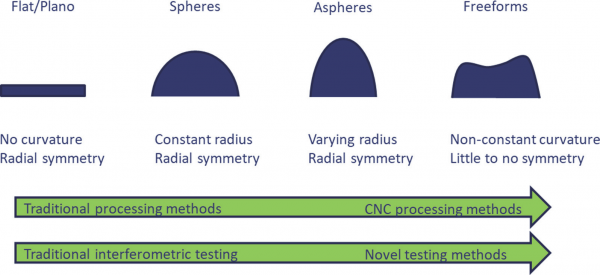What is optical freeform?
Freeforms are optical surfaces that lack symmetry. They have been incorporated into optical systems since 1972, when Baker and Plummer incorporated a freeform eyelens to correct for tilt, astigmatism and coma in a Polaroid camera. The freeform mold was fabricated using custom specialized grinders and hand polishing in the final form that was measured on a custom profilometer. Significant progress in freeform definition, design, fabrication and testing has happened, the increase in freeform use in optical designs have paralleled the increase in computing power. Increased computing power allows for faster computing speed for optical design software, data analysis, CNC processing and metrology analysis. Freeform surface definition and optical design continue to be active areas of research; a few of the methods include using polynomial equations, Zernike polynomials and NURBS (non-uniform rotational basis-spline) . These methods offer the options for freeform design with a complete lack of symmetry. Freeforms offer unique advantages in optical designs such as system miniaturization, ability to design off-axis systems and lighter-weight systems. Figure below depicts the increasing lack of symmetry from a flat surface to a freeform surface.

When communicating with the optical fabricator, the fabricator needs to have the surface prescription (e.g., equation), and in addition, optical manufacturers require a solid model for grinding platforms and coordinate measuring machines (CMMs), cloud of points for custom polishing platforms and commercial sub-aperture polishing platforms and optical models for testing freeforms with computer generated holograms (CGH) if that option exists. Options for making a solid model to sub-micron and sub-nanometer level accuracy is an area of active research. In viewing the optical model, the CNC toolpaths can be created and the surface can be evaluated for complexity and manufacturability (ex. rapid slope change within or outside the clear aperture). Total error for a freeform is a combination of surface form error and positional error. Small alignment errors (ex. 0.5° rotational offset) for freeform surfaces can manifest themselves as significant measurement errors (ex. 19 mm peak-to-valley astigmatism). In order to ensure freeforms are manufactured with low total error, fabricators measure surfaces relative to a global coordinate system, also referred to as fiducials. Freeform fabrication and testing methods continue to be an active area of research by several companies, universities and organizations.
The general freeform manufacturing process is shown in Figure below for a single freeform surface. Each surface requires special consideration, and it is critical to have the optical designer and optical fabricator collaborate closely in order to ensure that the optical system works as designed. Some of the consideration that should be considered in this collaboration is the surface prescription, surface extension, consideration about surface features and total error specification that includes fiducials.

